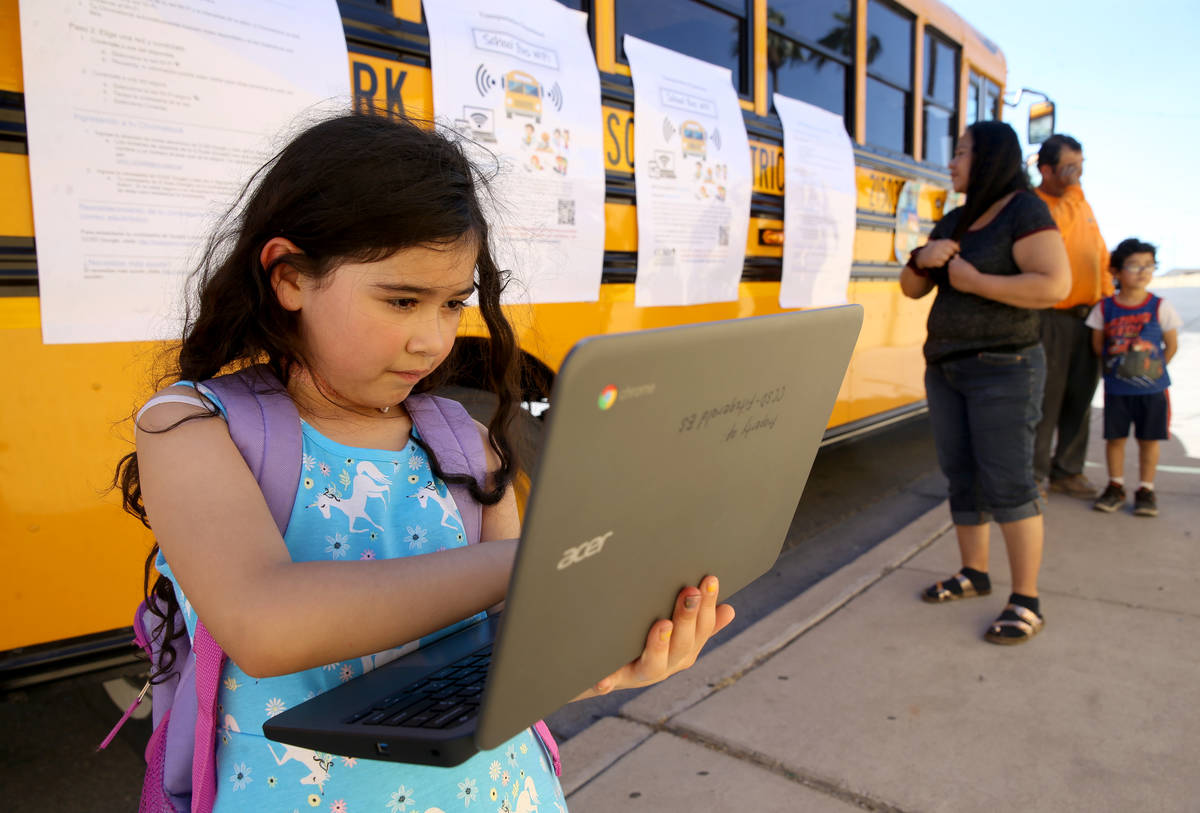Clark County School Board OKs online-only start to fall semester
Clark County School District students will start the 2020-21 school year remotely following a unanimous vote from the School Board on Tuesday to approve a full-time return to distance learning.
Trustees requested that they receive updates every 30 days on the status of COVID-19 in Nevada, with the aim of eventually transitioning to a blended learning model if health conditions allow, though no definite date was set for when students might return to school buildings.
Staffers will also be allowed to work in a hybrid model when and where possible, including for the first 10 days of professional development at the beginning of the year. Rural schools will be allowed to reopen under a hybrid model if they meet certain health and safety criteria.
On the agenda for discussion and possible approval Tuesday were three key items: the instructional model for the start of the school year; the schedule for secondary students, with options ranging from a four-course, semester-based schedule to a more traditional six- or eight-class option; and the format for professional development for staff, which could be in person or online.
In addition to distance learning, the board opted for a hybrid teleworking model for professional development for staffers, a traditional schedule for high school students and a semester-based schedule for middle school students.
Background
The board approved on July 9 a framework that included all these options in order to allow the district to meet a deadline set by the state, adding a caveat that any final determinations would come back before the board.
The Nevada Department of Education had said it did not need to approve the district’s reopening plan, only the calendar changes that would push the start of the year for students to Aug. 24 and institute 10 days of professional learning for staff members beginning Aug. 10. — approval that was granted on July 13
During the July 9 meeting and in the subsequent weeks, several trustees expressed their preference for full-time distance learning to start the year, and pressure has grown on the district to follow the lead of other major school districts that have chosen to keep buildings shuttered during the pandemic.
Many teachers have also said they would prefer distance learning, with a Clark County Education Association survey of over 11,000 teachers finding that 74 percent favor the model over school buildings reopening.
On Monday, the district also announced it would recommend distance learning to trustees, with Health Services Coordinator Linda Kalekas citing a number of data points, including the rise in COVID-19 positives and the increase in hospital occupancy that led to the recommendation.
Next steps
Before voting to approve the distance learning plan, trustees grilled district staff members on the details of its implementation, including how to get Chromebooks in the hands of students who need them.
Staffers have previously warned that supply chain issues could mean that the district may not have enough devices for students who express a need, leading to concerns that that the district would run afoul of the right to a free public education.
An online survey of district families sent last week indicated that 45 percent have access to a personal device, 21 percent have access to a CCSD device, 28 percent have access to a shared device and 6 percent have no device access at all. Though 95 percent of respondents said they have internet access, the online survey would not have been readily available to those without access.
In response to Trustee Chris Garvey’s question of whether the district would be out of compliance with federal law if it could not provide access to distance learning, Ignacio Ruiz, assistant superintendent of the English Language Learner division, said that as long as the district could provide a remote option, it would not be out of compliance.
When Trustee Linda Young expressed frustration over Chromebook and connectivity concerns, Superintendent Jesus Jara concurred, adding that various delays had affected the district’s ability to apply for grant funding for devices.
“We don’t have the ability to print money and get the Chromebooks here for our kids,” Jara said.
The district is planning to use $28 million in federal emergency funds for Chromebooks.
With principals returning to work this week, the district expects to send details of the reopening plans to the school level as well as resume preparing schools’ stocks of Chromebooks for distribution.
Other concerns from trustees included how to support special education students who struggle with distance education, or whose educational plans require in-person class time, with staff saying that teachers would be instructed to meet with those families individually in order to assess their needs.
The district did not offer any new answers on child care at Tuesday’s meeting but has said it would work with municipal partners on a solution.
Public preferences
Public comment posted ahead of the meeting ranged in reaction from those who implored the trustees to adopt the distance learning model to those who said it would be disastrous for education.
“My husband is on the front lines and I cannot compromise my family’s health, safety and well-being while members of the community cannot follow guidelines,” wrote a parent identified as Gina. “This is life or death for my family and my community. We have stayed home since March 16 to protect ourselves and protect you. It’s time for you to protect us.”
“I work full time in a hospital and have no one to supervise my children’s education,” wrote parent Krysten Fletcher. “Teachers are just as essential as all of us and need to be in the classroom with the children.”
“My biggest concern is how will distance learning meet special needs students’ needs?” wrote parent Sheila Lynch. “How will their IEP minutes be met?”
“If we go distant learning 100% then those without connectivity will not have access to their teacher or work till October. These are our neediest students,” wrote teacher Shawna Yelton. “What is the difference of students packing into daycare centers rather than having them in the classroom with a teacher?”
“In-person is so risky,” wrote Susan Pate. “We can not afford to gamble with kids’ lives. Let’s play it safe and get kids back when the time is right, not now.”
Contact Aleksandra Appleton at 702-383-0218 or aappleton@reviewjournal.com. Follow @aleksappleton on Twitter.























